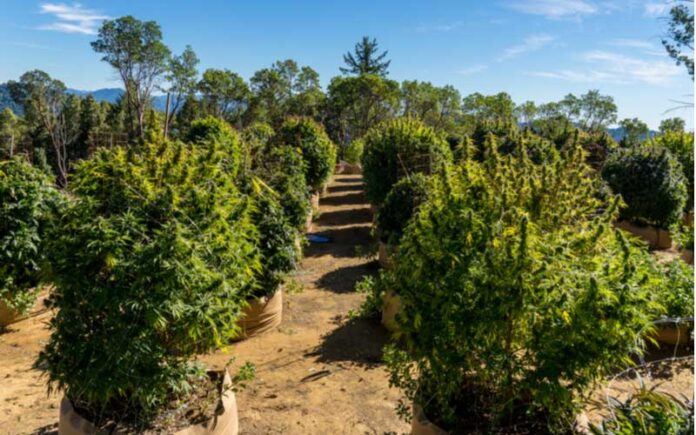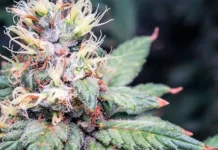An interview with an ecologist studying the West’s emerging, and rarely researched, industry.
Phoebe Parker-Shames is, as far as she knows, the first Ph.D. ecology student to concentrate solely on cannabis. Since she arrived at UC Berkeley six years ago, she’s been collecting data on wildlife and the cannabis industry in southern Oregon, where she’s from, focusing on the farms that operate in the shadow of federal prohibition. The plant’s legal status has long made it difficult for researchers to assess the impact of cannabis farming’s impacts, and Parker-Shames is the first to gather data on how the industry’s patterns and practices impact area wildlife.
In March, she published a landscape study of cannabis farms in Josephine County, Oregon. The first study to take a serious look at the growing industry’s extent, it revealed that, at a conservative estimate, cannabis is produced on 6% of all private parcels. Parker-Shames believes her mapping work and ecology research will not only help cannabis farmers, but also their communities, which are grappling with the industry’s trade-offs. “For the first time, an opportunity is emerging for communities to openly discuss what cannabis means to them, their local economies, and the environment,” she writes in her recent report, from increased water demands to impacts on local wildlife. But the industry remains an opaque one, and conclusive answers to key questions are hard to come by.
Recently, High Country News spoke with Parker-Shames about the role of science in policymaking, and what might best help Western communities that are navigating a “green rush” for the first time. This conversation has been edited for length and clarity.
High Country News: The cannabis industry has been under a prohibition for generations. In some counties in the West, growing permitted cannabis is legal, in others, it’s not. What has your research experience been like under prohibition?
Phoebe Parker-Shames: There were logistical questions like, “Am I even going to be able to do this work at all?” Then there were more of the impediments to day-to-day research — and obstacles to the type of research that I wanted to conduct — because of it being an illicit substance at the federal level. Most students, when they are stepping in to study an industry or system, they have decades of research and previous studies to build off. I have none of that for cannabis. That makes it really hard, and part of why I’m limited in the sort of conclusions that I can draw as a scientist. I must make the baselines myself.
HCN: Given climate change and the aridification of the West, many of our readers associate illicit cannabis with increasing demands on scarce water and possible environmental harm. What makes it tricky to draw such conclusions about the industry?
PPS: The very first thing I must point out is there is no one standard cannabis farm. That makes researching the impacts of cannabis extremely difficult. I don’t think I appreciated just how hard that would be until I started, but you’ve got huge variations in size. Everything from four plants all the way up to thousands: That’s an impossible range to make any sort of ecological conclusions about general impacts. Then you have things like differences in practice. Some people are using hoop houses, some people are growing in native soil, and most people are growing in bags. The use of fencing is pervasive, but also inconsistent in how permeable the fences are to local wildlife. Some people are using intensive irrigation systems, while some people aren’t. Some build in vegetation that could otherwise be wildlife habitat, clearing it and forming their farm there. Some people are coming into places that have already been set for agriculture. It goes on.
It’s an incredibly difficult question to answer. It can range from being perfectly compatible with local flora and fauna, all the way to being extremely detrimental to air, water, wildlife and people. I have been focusing my work on how we keep it at “most sustainable” and get people away from the large-scale industrial, super-high input with lots of disturbance.
HCN: What are you and other scientists still unable to study?
PPS: I would love to study the so-called “cartel” farms on public lands. We only have access to researchers who are partnering with law enforcement, and go and study them after a bust. Surveys and questions to farmers don’t end up reaching that community either. I think it matters because they’re in this vacuum of actual research. We don’t know how many there are, we don’t know what their most common farming practices are, and we don’t know how they feel about this topic or where they’re getting their information on how to cultivate.
Because of that, they become the boogeyman. Everybody else says this is the scariest, worst form of cannabis. Probably, but I don’t know; they only get studied after they’ve already been busted, which is not the same as studying an active farm. It’s also not feasible to do an interview with someone as they’re being arrested. That’s a whole population of farmers that I would love to know more about.
HCN: You write that your research is a tool to inform communities in making decisions about how and where cannabis is grown. What kinds of trade-offs do communities face?
PPS: For a long time, a lot of rural communities have depended on cannabis for their livelihoods, and at this point it is really embedded. So you’ve got some fundamental trade-offs, especially in a place like Josephine County, Oregon, where the cannabis industry is essential for the functioning of the county. It’s deeply intwined into the economic system.
If you are uncomfortable with seeing the economic or the ecological impacts of this industry, or if your gut reaction is, “I don’t like what’s happening with this industry, and I wish it would go away,” then you have to recognize that there are economic trade-offs. I went into this work specifically because I care about these communities. I would prefer us to think about the ways in which we cultivate, rather than whether or not we cultivate. If you wanted to enforce every single person who is cultivating illegally, that proportion of the entire population of the county, we would live in a police state. You can’t regulate something that is illegal.
HCN: Western cannabis farmers are becoming more visible, and so are the impacts of an increasingly industrialized model of cannabis farming. Many readers are feeling this “green rush” for the first time. Can you highlight strategies for how communities, their governments and farmers can effectively mitigate negative ecosystem impacts?
PPS: One of the critical steps is to increase dialogue between policymakers and regulators and the people impacted. Too often, when we think about who our community is and who gets input on these regulations, we exclude some cannabis farmers because they’re operating in an illegal space.
In my mapping work — a conservative estimate from 2016 — we found that was that cannabis was grown on 6% of all private land parcels. That is a huge proportion of the land owned in the entire county. Even now, most of them are probably not legal. If you want to make recommendations for how people cultivate — if you want to encourage them to use those most sustainable practices, or at least the least harmful ones — you’re going to hit roadblocks if they’re growing illegally. So really, a more effective way to change this is to get them into the legal market, and then make policies about how you want them to grow and where you want them to grow — but not “don’t grow.”
I have been studying cannabis and ecological outcomes in Josephine County for the last five years. There is no easy, fast way to know who is doing the most harmful impacts. I am confident that law enforcement doesn’t have access to that information either.
HCN: As a scientist studying cannabis agriculture and ecology, what is the one question that’s most on your mind right now?
PPS: We know that the policy landscape is a bit of a mess. But where do we go from here? I have these recommendations about policymakers engaging with farmers and having community discussions where we think about trade-offs, but I don’t know how to get people to sit down and do that.














